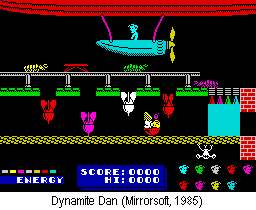|

By Lloyd Mangram
July
1985
Issue 18
|
|
The
Dun Darach cover painting caused a fair stir
- some readers reported seeing the magazine on newsagents'
top shelves - though the subject matter is really only
a fond reworking of many a pulp SF / sword-and-sorcery
theme. As usual, Oliver did not move far away from the
Spectrum references either; note the rainbow colouring
of Skar's cloak and the air round her. Perhaps the erotic
connotations of having a man in bondage to a woman,
even if a sorceress, were too much for some chauvinist
CRASH readers, who would feel the same about Issue 31
with its Hannah Smith cover.
|
A dark month for the software business: confirmation arrived
that Fantasy had definitely gone, and the financially ailing
independent Micromania was being forced into liquidation,
unable to withstand the loss of payments after its distributor,
Tiger, collapsed. It seemed a shame; never a front-runner,
Micromania had nevertheless produced a handful of interesting
games, last but not least being Project Future, a Smash
in Issue 14.
The biggest failure, however, was that of Bug-Byte, which
went into receivership during June. Bug-Byte was founding
father of the home-computer game and many well-known individuals
and several software houses had sprung from the Liverpool
company. To be fair, the quality of Bug-Byte's products had
dropped; still, it was a sad surprise to many causing almost
as many fears that the end was nigh as had Imagine's disintegration.
But, like Imagine, Bug-Byte would be resurrected: Argus,
unable to confirm a merger deal before Bug-Byte went into
receivership, later purchased it from the receiver to use
as a budget label.
 And,
to paraphrase, in the midst of death there is life: up came
Mirrorsoft. After a short and low-profile history of educational
software, Mirrorsoft suddenly produced Dynamite Dan,
the ever so attractive Jet Set Willy clone which because
of its playability, clever map and fiendish difficulty well
deserved the Smash it received. And,
to paraphrase, in the midst of death there is life: up came
Mirrorsoft. After a short and low-profile history of educational
software, Mirrorsoft suddenly produced Dynamite Dan,
the ever so attractive Jet Set Willy clone which because
of its playability, clever map and fiendish difficulty well
deserved the Smash it received.
It was a good month for quality games, in fact. Dun Darach
left Cuchulainn fan Robin Candy in paroxysms of delight as
he reviewed Gargoyle's third game (and pleased Roger Kean,
because he had a credit in the inlay for thinking up the idea
of numbering all the houses, a suggestion he had offered Gargoyle's
Greg Follis during the LET Show). Only recently established
on the 64, Palace Software converted its Commodore hit Cauldron
to the Spectrum and had it Smashed, while Mikro-Gen revived
familiar graphics and puzzles with Herbert's Dummy Run,
in which Wally Week took more of a back seat as his toddler
son Smashed up the shop.
What these very different games had in common was that they
were new neither in ideas nor in gameplay but their implementation
was exemplary. Programmers were now concentrating on providing
a long, complex game with large, densely detailed graphics
and decent helpings of humour. None of these virtues applied
to Domark's big game, though. For the majors, fighting a battle
for the best licences going, it must have been galling to
see Domark pick up James Bond in A View To A Kill,
especially as the multipart game proved a great disappointment.
How could I know that in another year, the CRASH enthusiast
whose Forum heading I used in this issue - a 'desperate art
student' who'd sent his drawing to the Bug Box - would be
working for Newsfield? Was I to blame for Richard Eddy?
ZZAP! staff writers Gary Penn and Julian Rignall arrived
in Ludlow during June, halfway through work on their issue.
This was the moment when Roger Kean, perforce of necessity,
took over editorship of ZZAP! and relinquished his role on
CRASH. It seemed to many readers a traitorous act from the
man who had become so firmly associated with the Spectrum,
but in fact Roger continued to keep an eye on the magazine
he had helped found a year and a half earlier, as Graeme Kidd
moved up from Assistant Editor to Editor.
In the battle for circulation - and CRASH's was rising fast,
threatening the longer established titles - it seemed to be
vital to be seen to be first with the reviews. CRASH staff
were increasingly exercised over rival magazines getting to
review some games before we did - one magazine, now defunct,
appeared to rate on the basis of seeing unfinished copies.
It was aggravating, and the situation was about to boil over
spectacularly . . .
|